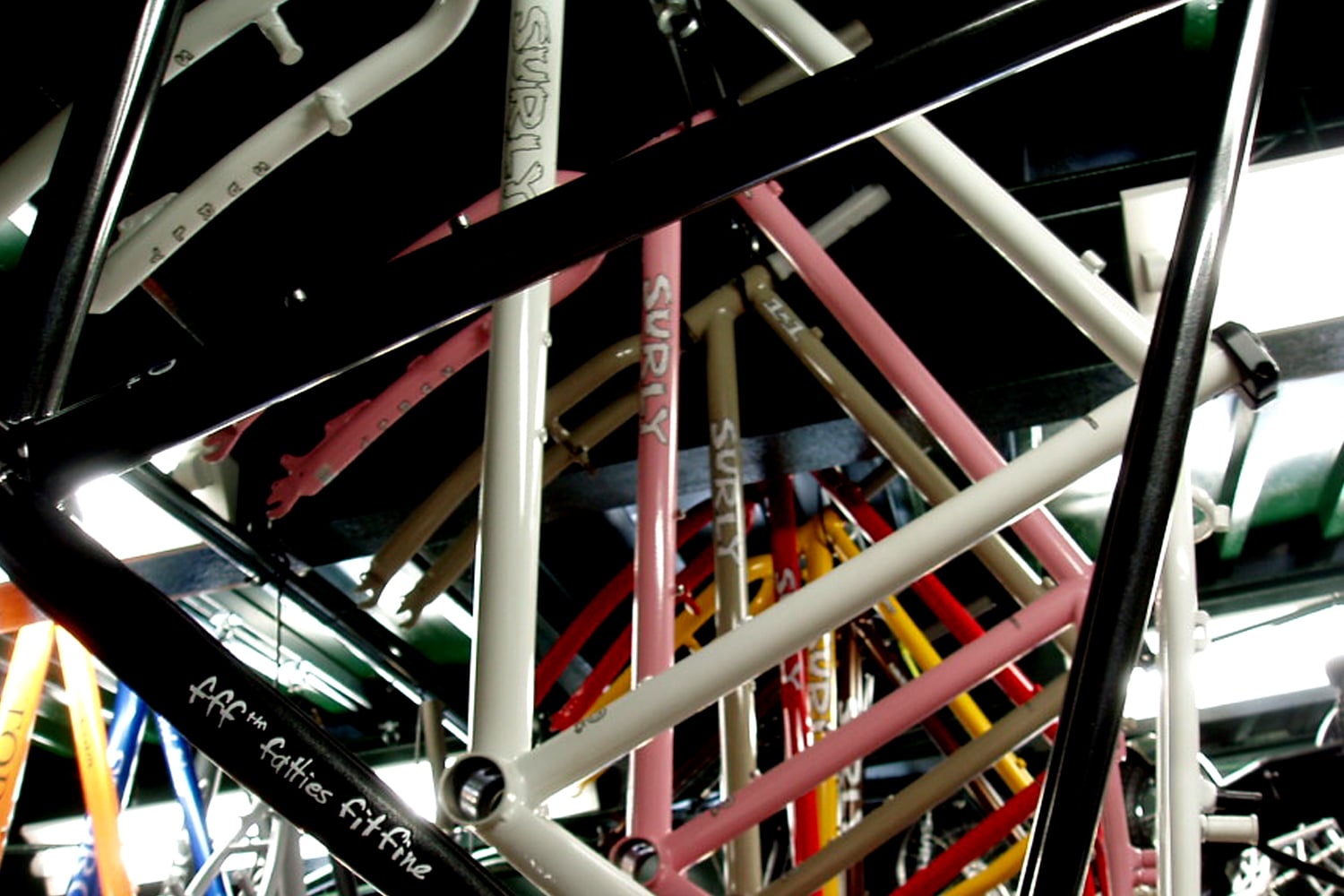The Arrowhead 135 is a 135-mile human-power race (run, ski, or bike) that follows the Arrowhead State Snowmobile Trail from International Falls, MN (“the icebox of the nation”) to Tower, MN…usually during the last week of January or the first week of February. Temperatures and trail conditions vary on the trail from year to year, day to day, and, sometimes, hour to hour. Every year, a percentage of the racers succumb to mental and physical fatigue, physical injury, hypothermia, and equipment failures. It is a challenging event – a true test of mind, body, and spirit.
I’ve raced the AH135 for the last 8 years, because it scratches a few itches for me. It’s an opportunity for me to push myself physically, trying to go a little faster than years previous. It allows me to test some of the gear-choice and food-choice theories that popped into my trail-weary melon during the previous year’s race. It gives me a chance to try out new Surly products in changing, real-world conditions. It’s an opportunity to catch up with some old friends. And it’s a time for me to think about everything, without much distraction, while I’m out on the trail.
The Bike
Like most years, I chose my race rig long before registration opened. I’ve been riding a Bud (4.8”) on the front and a Lou (4.8”) on the rear, so I figured I’d stick with the big, aggressive rubber for this year’s race. I swapped out a prototype crankset for a more current proto of our new O.D. (offset double) crankset. And I exchanged my Titec J-bar for a widened Jones Loop bar. It’s, more or less, the same bike I’ve been riding for the last year…a known quantity.
Here’s a basic run-down of the build… Wheels: Rear…Lou, Clown Shoe, DT 350 hub, DT 1.8/2.0 spokes, DT brass nipples, Surly rimstrip, Surly tube; Front…Bud, Clown Shoe, Surly Ultra New 135mm single-speed disc hub, DT 1.8/2.0 spokes, DT brass nipples, Surly rimstrip, Surly tube. Drivetrain: O.D. crankset (20t/34t chainrings) with Surly bottom bracket, SRAM 971 chain, SRAM 15-34 7-speed cassette (2 cogs removed from a 9-speed cassette). Brakes: Avid mechanical disc brakes, Dirty Dog rotors (dragons!), and Shimano Deore levers. Shifters/Derailleurs: Microshift thumbies, Microshift mid-cage rear derailleur, Shimano STX direct-mount front derailleur. Misc: Ritchey seatpost, WTB Pure V saddle, Jones Loop Bar, Salsa stem, Cane Creek 40 headset, Odyssey Triple Trap Pedals.
I used Revelate Designs bags to carry the majority of my gear...Moonlander/Pug framebag, Viscacha seatbag with Spocket, Gas Tank, Jerrycan, handlebar harness and harness bag. I chose 5-liter POE drybags, cinched into Salsa Anything Cages mounted to the fork blades, to carry lightweight/bulky clothing items.
Mandatory Gear
We are required to carry items from a mandatory gear list. If chosen wisely and used properly, this stuff should keep me alive and well if things get ugly on the trail. I bring items that I know and trust. I've used all of it, in the field, at some point. It's not always the lightest stuff, but I'm confident that it will serve me well if needed. There won't be any unpleasant surprises, if I'm forced to rely on it. Here's what I carried this year: Sierra Designs minus-20F down bag, Thermarest Ridgerest sleeping pad, Equinox bivy, cheap adjustable lighter, titanium Esbit stove, 12-pack of Esbit fuel tabs, 500ml titanium pot w/lid, Isotherm insulated 1-liter bottles (2), Princeton Tec Epic Pro headlamp, Cateye 3-LED flashers (2), a whistle on a string around my neck, reflective triangles and reflective strips (attached to my boots), and a small jar of peanut butter (3200 calories).
I hope I never have to use my emergency food rations (jar of peanut butter) or my reserve of stove fuel (Esbit tabs) because 1) it will mean I'm probably in tough shape and 2) It will disqualify me. But it's nice to know it's there if needed. I've never used my shelter, my stove, or my bag during the race, but I know many who have...even though they didn't plan on doing so. Those items are truly lifesavers. And I'm glad that Don, the Gear Nazi, is there to make sure everybody has what they need to keep themselves out of harm's way...as much as can be expected, given the circumstances. Of course, a person has to know how and when to use those lifesaving tools. Otherwise, they simply have no value.
Clothing
Clothing worn (layering inside to outside)… Head: Pearl Izumi headband, WSI Flippy Cap. Torso: Ibex short-sleeve base layer, Ibex long-sleeve zip-neck base layer, Empire Wool and Canvas Co. (EWCC) Grey Fox coat (customized), Montane Pertex shell. Legs: Ibex windfront boxer/briefs, Craft tights, Race Face knickers. Hands: WSI liner gloves, EWCC Icebike Mitts. Feet: WSI liner socks, plastic bags (vapor barriers), Fox River ragg wool socks, EWCC True North Boots.
I’ve been riding in wool, leather, and canvas clothing, from Empire Wool and Canvas, since last year. I love this stuff. My winter-riding mindset has been changing. I like knowing that I’ll be comfortable while I’m pedaling, when I break for tea mid-ride, and when I have to stop to deal with mechanical issues. I find that natural materials tend to breathe better than most of the plastic garments I've used over the years. I stay warmer, drier, less stinky, and, ultimately, more comfortable when I’m wearing clothing made from natural fibers. Obviously, I've listed some synthetic clothing items above. I like plastic clothes for their durability and/or water resistance. They often work well in conjunction with the natural-fiber items. I think I've found a good synthetic/natural balance.
I wore an Empire Grey Fox wool coat during every cold-temperature work commute this winter. I have two of them…a proto half-zip and a custom full-zip. I’ve used them in temps from minus-10 to 50 degrees F. There was no need to second-guess my choice for the race. If the temperature had been much colder, I would have supplemented the Fox with a new lightweight cotton parka (prototype) from Empire. I used an ultralight Pertex shell, toward the end of my ride, to keep the snow from accumulating and melting on the wool coat.
I was able to get by with only WSI liner gloves for the first half of the race. When the snow began to fall, I added the wool liners from my Empire IceBike Mitts. Eventually, I donned the IceBike shells. I love having a system that can be adjusted for the conditions. If the need had arisen, I could have added another wool liner mitten layer and/or vapor barrier gloves. I’d feel comfortable with this system down to minus-40 F. I rode in the IceBike Mitts all winter. They are bulky (I wear XL), but they are warm and comfortable. I use thumbies on most of my bikes, so the bulk isn't a problem.
Like my handwear, my footwear is scalable to deal with a wide range of winter temperatures. The True North Boots are like mukluks on steroids. The flex of the sole promotes circulation and, unlike a traditional mukluk, the TN Boots lace from the toes to the upper calves. So one can adjust the fit to accommodate a wide array of insole and sock choices.
The mild conditions allowed me to ride without a headband or cap most of the time. But, eventually, the wet snow made it necessary for me to add the PI headband and, finally, the WSI Flippy cap to stave off a permanent chill. The Flippy cap is named for one of its features: the earflaps flip up when not needed. I usually carry this cap in my spare clothing kit. It's light, it doesn't take up much space, it easily fits under a helmet, and it works very well to completely cover my ears. That's where many caps fall short.
Food
I carried a lot of the food I’ve used in years past: bacon, Slim Jims (mild), crushed cheddar-flavored potato chips, crushed Chili Cheese Fritos, peanut butter cups, smoked almonds, salted cashews, dried cherries, chocolate-covered raisins, Ginsting Honey Stinger gel, Honey Stinger waffles (lemon), Honey Stinger chews (lime), Gummi Bears, 5-Hour Energy, and super-special homemade dessert bars.
I had a tough time eating on the trail. It could have been the warm temps. The furnace simply didn’t require as much stoking to generate heat. I made the mistake of using 5-hour Energy supplements, again, this year. Last year, they didn’t sit well with me; I experienced some stomach discomfort. I got the same results during this year’s ride. Lesson learned. Scratch those off the list.
I craved cola throughout the race. I had some Coke at the midway and final checkpoints, but I wanted more as soon as I hit the trail. Maybe, I’ll incorporate a can or two into next year’s food bags.
Race Prep
I was relatively well-prepared for this year’s race. I started my shopping, sewing, wrenching, packing, and gear mods a week before the race. Usually, I wait until the last minute to get my equipment sorted out.
My dad (Jerry) picked my son, Noah, and me up at 6AM Sunday morning. We loaded up our bikes...my Moonlander and Noah’s new 14” Pug, and secured them next to Dad's purple Pug in the box of the truck. We piled the rest of our gear around the bikes and in the cab and had just enough room for Noah to ride comfortably in the back seat. It didn't take long to get things situated and strapped down for the 5-hour drive north to International Falls. We were on the road by 6:30.
We arrived in International Falls before noon…in plenty of time to complete the mandatory gear check and settle into our hotel room.
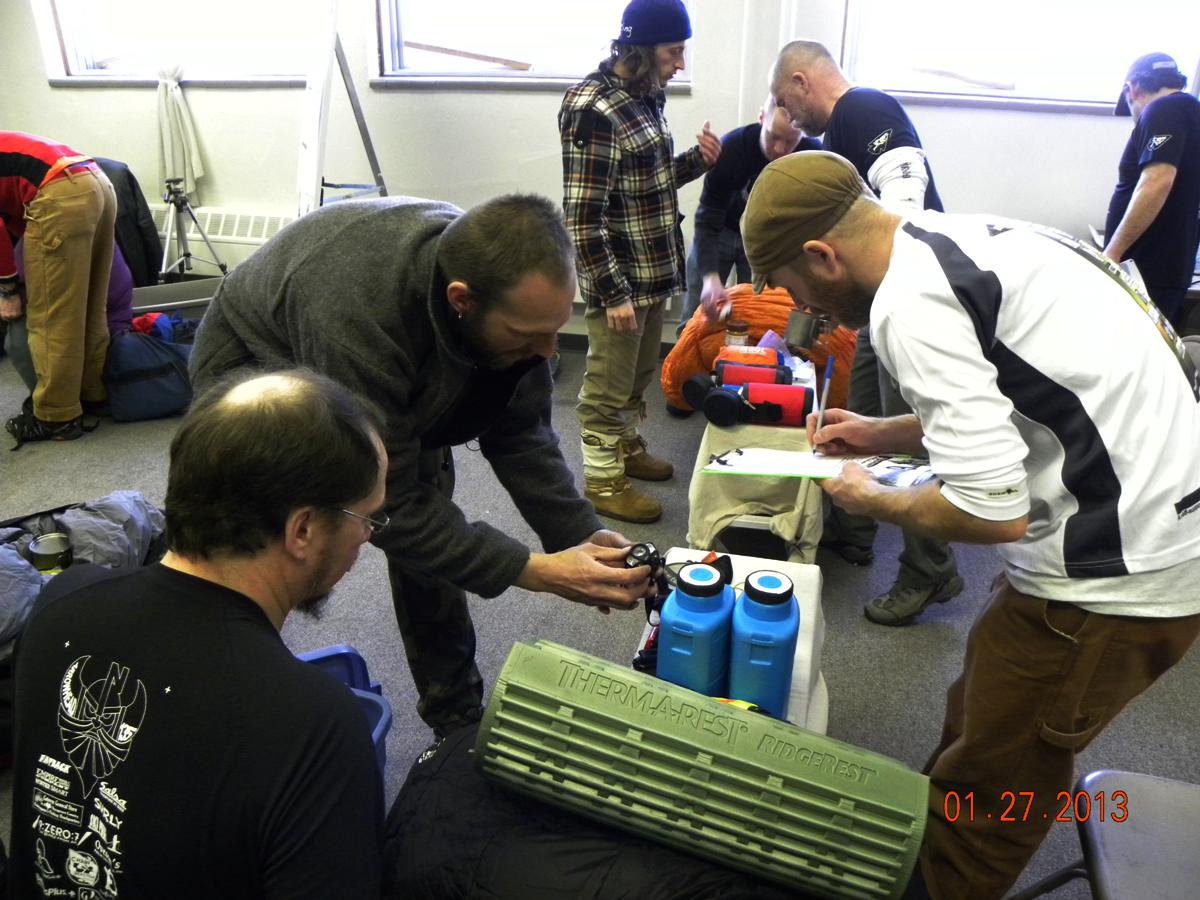
After attending the pre-race meeting, we returned to our hotel so Noah could swim and I could pack. Then we went out for an early dinner…not unlike the routine of prior years. When we got back to the hotel, Noah went swimming again, Dad socialized a bit, and I messed around with my bike and clothing a little more. I like to have everything ready to go...bike packed, clothing set out, non-race stuff packed to go back in the truck…before I retire for the evening.
I showered and turned off the lights around 10:30. I slept well.
We were up by 5:30AM Monday morning. This year, we prepared breakfast in the hotel room instead of having Dad run to McDonalds. Mom had prepared and packed bacon, pancakes, hashbrowns, and orange juice for us. She hates the race, because she can't stop worrying about me until she knows I'm safe and sound and done riding. I appreciate that she is still willing to support me, despite the extra stress it causes. We nuked our food in the microwave provided in the room. Dad grabbed us coffee at the hotel continental breakfast buffet. That worked great. I’m not picky about breakfast. It doesn’t have to be gourmet. I just need to get calories in my system before I ride.
I was dressed, out the door, and pedaling toward the Kerry Arena, the race starting point, at 6:40. It’s an easy 10-minute ride to the arena. I like riding vs. driving to the start, so I can make adjustments to the bike and clothing before the gun goes off.
The Ride
Bikers go off at 7AM, followed by the skiers, and then the runners. By 7:04, 135 racers were headed down the trail toward Tower, MN…135 miles away.
It was 25 degrees (F) when we started. It didn’t take long before I was adjusting clothing. My coat and long-sleeve Ibex base layer were unzipped, and my head was bare after 15 minutes of riding. The lightweight WSI liner gloves were sufficient for the mild morning temps.
I started with 12 PSI in Bud and Lou, but soon dropped the pressure to better deal with the soft trail conditions. I made minor adjustments throughout the race…finishing with 7 PSI front and rear.
Like the other riders, I searched for a comfortable cadence and a place in the pack. It didn't take long to settle into a sustainable rhythm.
My dad volunteered at one of the first major road crossings…flagging racers across when the road is clear, so I stopped for a minute to talk with him and Noah – and take a drink of water – when I got to them. Even though it was early in the race, it’s always nice see them on the trail. One advantage of not being worried about (qualified for) a “podium” finish: the opportunities to stop and chat, along the way, without getting stressed about losing a place in the race.
At the first shelter…where we take a left and start riding east, I stopped to hydrate and take in some calories. Pat White and Chuck Lindner stopped, too. Most years, I have the opportunity to ride with Pat and Chuck, at some point, during the race. Even if it’s only for a few minutes at a pop…it’s fun to interact with some of the regulars who come back, year after year, to accept what the Arrowhead Trail has to offer. Technically, we are competitors, but nobody really pays much attention to placement behind the first 2 or 3 finishers in each class. This event is a lot of things to a lot of folks…a middle finger raised to the elements; a race against the clock; a mental challenge against long hours slogging forward in the dark; a time to ponder; a time to hallucinate; a chance to take in the quiet, often sparse beauty of the Arrowhead Trail; a chance to test (and justify) those new shiny toys; an opportunity to push oneself beyond normal pain and endurance thresholds… The list goes on and on.
My dad and Noah were waiting at the Hwy 53 crossing. I stopped for some pics, to give Noah a hug, and to suck down some water and a Honey Stinger packet. Noah was proud of the 16 steel spikes he’d already collected from the railroad track running parallel to the highway. He’s 9. That’s what 9-year-old boys do…they collect treasures. Hell…I’m 43, and I do the same.
The AH is a really good opportunity for Noah to spend time with his grandpa…and vice versa. I pulled Noah from school Monday and Tuesday to come to the race again (he came last year, too). He learns a lot more at the race than he would in an underfunded Minneapolis public school. And I'm sure he will attest to the improved quality of the lunches.
6-8 riders passed as we chatted. No worries. I knew I had 15 – 20 hours left to catch them, if I could. 1 or 2 minutes means nothing, unless you’re one of the big dogs up front. I wasn’t chasing anyone. I wasn’t being chased.
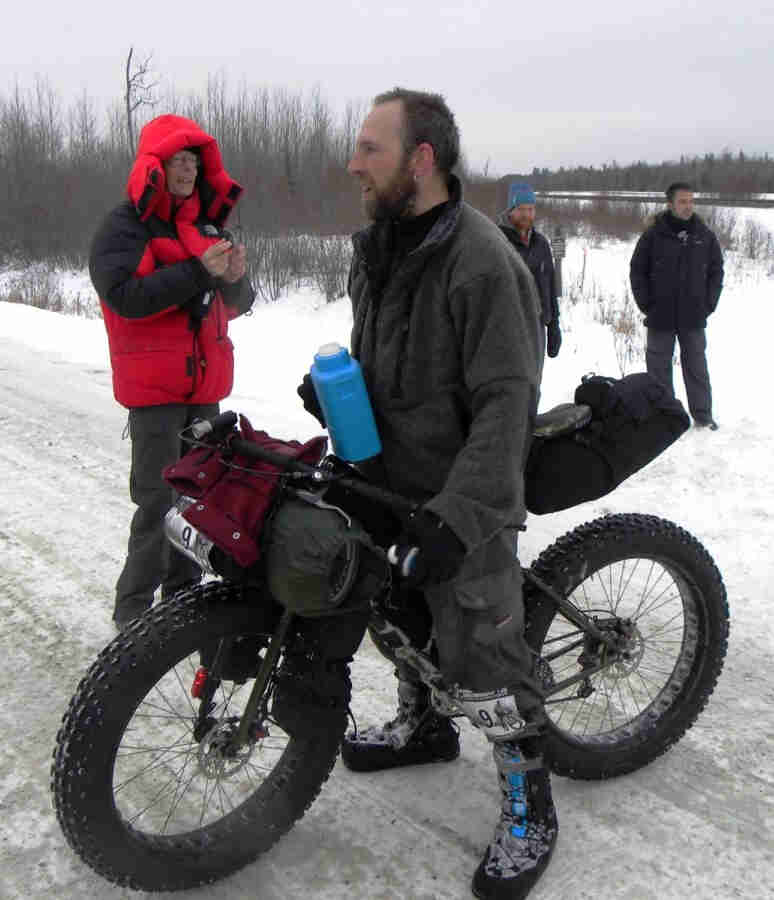
Off again. I passed riders and got passed. I caught up to Lindsay Gauld. I always enjoy riding with – and talking with – Lindsay. Most years, we move down the trail at the same average speed…trading positions in the rider field over the course of 20 – 25 hours. It was announced, at the pre-race meeting, that Lyndsay could hit his millionth-kilometer-pedaled mark on his Arrowhead 135 ride. Knowing Lyndsay, I was pretty confident that he'd hit that mark and finish the race in a respectable time.
When I got to the first checkpoint, the Gateway Store, Noah and Dad were waiting for me. I had already formulated my game plan for the stop. Since I had lots of calories remaining in my bags, I didn't need to buy any food from the store. And I wasn't going to stay very long. But I was thirsty and cramping up a bit. So I filled my water bottles, chugged a Gatorade, and wolfed down some cold bacon.
Noah was riding his Pug around in the parking lot. I could tell he was having fun. Normally I’d tell him to put his helmet on, but I wasn’t wearing one either. I wasn’t going to be a hypocrite. And I figured that his thick, insulated hat would likely provide a bit of protection in the unlikely event of a crash. That child is hard-headed, anyway. He must get that from his mother.
After we took some quick photos, I was back on the trail. It seemed pretty slow. Snowmobiles had passed coming the opposite way, so the tracks of the riders in front of me had been erased in many spots. I was busting new trail for a while.
I passed riders and got passed by riders. At times, I was very pleased with my decision to run the wide rim/big tire format. Other times...when the trail was firm, the large-format wheels slowed me down, and I had to second-guess my equipment choice.
During the daylight hours, I make a point of observing and appreciating the beauty of the northern woods and enjoying the company of my riding companions. We are still grouped relatively close together. That tends to change after we reach the mid-way checkpoint.
Mike Riemer…Salsa marketing guy, pro photographer, old friend, and co-worker…was out on the trail taking photos. I stopped to talk with Mike for a bit. I was in no rush, and I welcomed the chance to stop pedaling for a spell. As I mentioned previously...it’s nice to have the time to chat. I took off, again, when the next rider came into view.
Dad’s truck was parked at the Sheep Ranch Road crossing. I stopped to say “hi”. Noah was asleep in the truck. Pugsley had kicked his ass. I could relate.
After getting a brief update on where people were on the trail, I continued on. I wanted to get to Melgeorge’s Resort, the midway checkpoint…69 miles from the start, before sundown. I knew it was possible and likely, if I just kept churning forward at my pace.
At that point in the race, I was getting low on energy. I couldn’t eat much. I felt slow and sluggish. I blamed the equipment at times. But, deep down, I knew it had more to do with my lack of usable calories. No fuel intake – no energy. I was re-tasting the 5-hour energy drink I’d consumed. That taste stuck with me for the rest of the ride. I tried forcing down bits of food, here and there. I sampled the contents of every Zip-lock in my harness bag, hoping to find a catalyst for an appetite. Nothing tasted good. The thought of consuming another packet of Honey Stinger gel made me wretch.
A downside of riding the Arrowhead multiple times: knowing how far it is to the next checkpoint and dreading the push up some of the big, unrideable hills. Some of the hills, before Elephant Lake, just suck…especially when you don’t have any fuel in the tank. It doesn’t help that I pack with a survivalist mentality. I don’t pack like a racer. I tote a fixed-blade bushcraft knife AND a Leatherman. I carry several tools to make fire. I’m equipped with a first aid kit, cordage, tape, a proven tool kit, a sewing kit, and clothing to keep me comfortable well below zero. I’m prepared to live outside, to melt snow to make water, to repair most of my gear, and to find or build a shelter and/or build a fire to stay warm if the need should arise. I don’t want to blame my equipment, or a lack thereof, for a race that I can’t finish.
My spirits always lift when I hit the edge of Elephant Lake. The midway checkpoint cabin is only about a kilometer away. But the tracks ahead of me weren’t very packed, and it was a slow roll across the lake. At least, the hills were behind me for a little while. And the promise of a warm, dry shelter ahead gave me a little boost.
My dad met me at the edge of the lake when I arrived at the resort. Noah was still sleeping. I was a little jealous. I could have used a nap.
The Arrowhead race volunteers are always top-notch. After I entered the checkpoint cabin, I had a grilled cheese sandwich, a bowl of soup, and a cup of Coke in front of me within a couple minutes. Real, warm food stimulated my appetite, and I took advantage of the opportunity to pack in some calories for the next leg of the annual journey.
The checkpoint cabin can suck you in using the temptations of warmth, rest, and generous hospitality. One of my goals for the year was to minimize the time spent at each checkpoint. I’ve spent hours at Melgeorge’s in years past. I know it’s highly unlikely that I’m going to be sprinting for a photo finish, but I always want to push myself…to do better than the year before…to finish with a time that just happens to be a personal best. Minimizing my checkpoint times, within reason, could effectively shorten my overall race time…or I could screw myself by not taking enough time to rest, recover, and resupply. I figured I’d eat, I’d refill my foodbag with some of the items from my drop bag, and I’d refill my water bottles…all at a relaxed pace. Then I’d go.
I got to spend a little time with my dad and Noah. There wasn’t much conversation, because I was feeling a little worked and there was a lot going on in the cabin. But I really appreciated having them there…especially for the sendoff into the dark night.
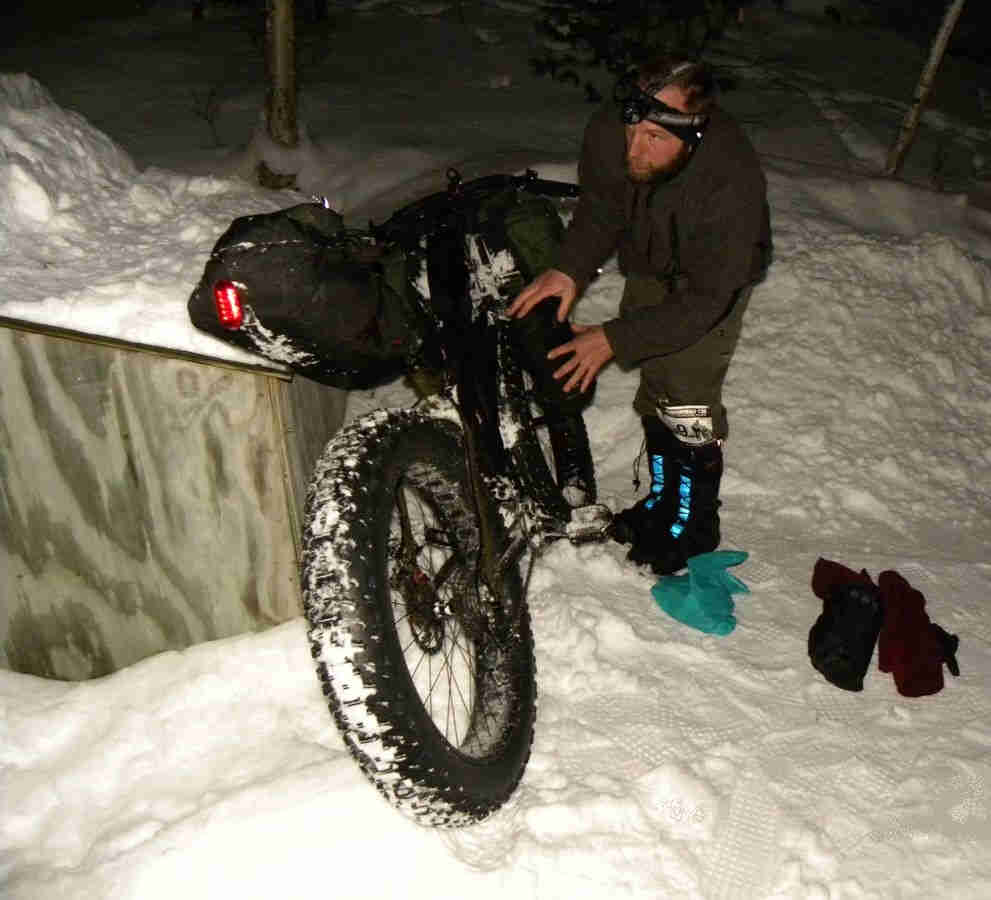
I packed up the Moonlander, gave Noah a hug, turned on my headlight, and rolled off toward the familiar trail entrance. Dad and Noah were headed to their hotel room at the casino in Tower, so I wouldn’t see them again until my race was finished.
I rode alone. Thick clouds blocked out the light of an almost-full moon. A headlight was necessary most of the time. I kept my handlebar-mounted Princeton Tec Push on “low” for the remainder of my ride. I used my Princeton Tec Apex Pro headlamp, in addition to the Push, on the fast descents. One of my gear improvements, prompted by a need to use the Apex switches while wearing heavy mittens, is a modification of the switches…reshaped (ground) ball bearings glued to the switch membranes using Aquaseal. The mod worked great.
I was on the trail for an hour - maybe, an hour and a half - when heavy, wet flakes began to fall and fill in the tracks I’d been following. It was expected, but not welcomed. I knew that no good would come from a sizeable accumulation of snow. Even with my aggressive tire choices, my average speed was guaranteed to decline.
Due to the light reflecting off the big flakes, my headlamp became more of a hindrance than a help on the fast downhill sections of the course. I refrained from using it when the snow fell fastest/heaviest, relying solely on the handlebar light much of the time.
A couple hours after leaving Melgeorges, I finally saw the telltale strobe of another rider. The “cat and mouse” game was on. Having a goal - catching someone ahead of me – gives me something to focus on. So my speed increased a bit, I passed that rider (I can’t remember who) and I made up a place. That scenario would play out again and again as I moved toward the finish line. As the snow continued to pile up, Bud and Lou were proving themselves against the comparatively smaller and less aggressive tires on other bikes.
Most of the steep uphill sections were unrideable after 80-100mm of snow had piled up. I got a lot of mounting/dismounting practice during the race. After a while, one gets a pretty good idea of what can be ridden and what can not be ridden…usually by studying the tracks of the riders ahead. I proceeded accordingly. There’s no sense wasting valuable energy trying to ride a hill when walking is ultimately faster and less taxing.
The increased amount of energy expenditure, caused by the snow, made me sweat more than I usually do…which forced me to rehydrate more than usual. Eventually, my water supply dwindled to nothing, and I resorted to eating snow. Normally, I wouldn’t eat snow to rehydrate, but the warm air temperature and new, clean snow made it feasible, safe, and desirable. Each time I dismounted to walk a hill, I grabbed a handful of snow and shoved it in my mouth. Slowly, my nagging thirst subsided.
The hills seem endless, sometimes. Maybe, that’s what makes the last checkpoint even better; it signifies that the end of the hilly section is very close. When I rolled in to the 3rd and final checkpoint…pushing my bike up the small hill toward the warm glow of the fire, Lance and Terry were there weighing their race strategy options. Lance was strongly considering a bivy down the trail. Terry was experiencing some hand numbness and was unsure of his next move. It was still snowing heavily, and the trail conditions were getting notably worse as the clock ticked. I decided to fill up with water, drink my fill of Coke, and get moving again before the fire had any chance of lulling me into an extended stay.
I plowed on, trying to stay in the faintly recognizable tracks of the riders who had gone before me. Sometimes, that worked. Sometimes, it didn’t. Regardless, I was able to keep pedaling as Bud and Lou found traction at the bottom of the deepening layer of frozen precip. I spent a lot of time in my granny gear. Progress was slow, but pedaling was faster and more efficient than walking.
After tackling the last major hill on the course, I found myself on the familiar, relatively-flat part of trail that continues on to the finish line. Riding this 40km section is always an exercise in tedium. It’s as much of a mental challenge as it is a physical challenge…especially when the pace is slow.
I caught up to Lyndsay and Tim Ek. We talked a bit as we progressed toward Tower. Lyndsay had passed his 1-million-kilometer mark by this point. Very impressive…but not surprising.
I got a little mental energy boost from moving up a couple more places, so I increased my cadence a bit to see if I could reel in one more rider before the end of the race. My finish time and placement isn’t really that important, but chasing another rider, real or imaginary, is something to focus on…other than simply trying to stay upright and pointed straight down the trail.
Minutes and hours passed without any sign of a red blinky light ahead of me on the trail. Eventually, I made it to the recently-groomed section of trail that led to the finish line at the casino. The fresh surface looked deceptively fast. But the serpentine bike tracks, punctuated by foot tracks, told the true tale. The groomer had churned up the snow, and it hadn’t set up firmly. That push to the finish turned out to be one of the slowest, most frustrating parts of the ride.
I constantly hunted for the fastest line and struggled to maintain momentum. At times, I was forced to dismount and walk. When the finish line, at last, appeared, I was elated at the thought of being done. I tried to finish strong, but the conditions wouldn’t allow it. I pushed my bike up the last small hill and barely managed to ride the last few meters of the course before rolling through the finishing gate 23 hours and 54 minutes after starting my ride. Good enough for 16th place. I’m happy with that…especially knowing that only 35%, of the 135 starting racers, finished the race, this year. It was a tough one for those of us who didn't beat the snow. Ironically, it was also a record-breaking year for the fast guys. They stayed ahead of the heavy clouds and put all their energy into going fast instead of fighting the trail. Nice work, fellas.
Over the last 8 years of my participation in the AH 135, I’ve pushed and ridden my bike approximately 1015 miles on the Arrowhead Trail…not counting all the extra miles added while taking wrong turns and backtracking during the early years of the race. Despite my experience, it doesn’t seem to get much easier…even when it’s not snowing. This year, I suffered the usual aches and pains associated with riding and pushing a loaded fatbike for the better part of a day. My shoulders, hands, neck, legs, and ass were sore. I was a little more chafed than usual...maybe, from riding in wet tights. I'll spare you the details. And, after riding in wet gloves for a good portion of the race, my hands looked like bleached prunes.
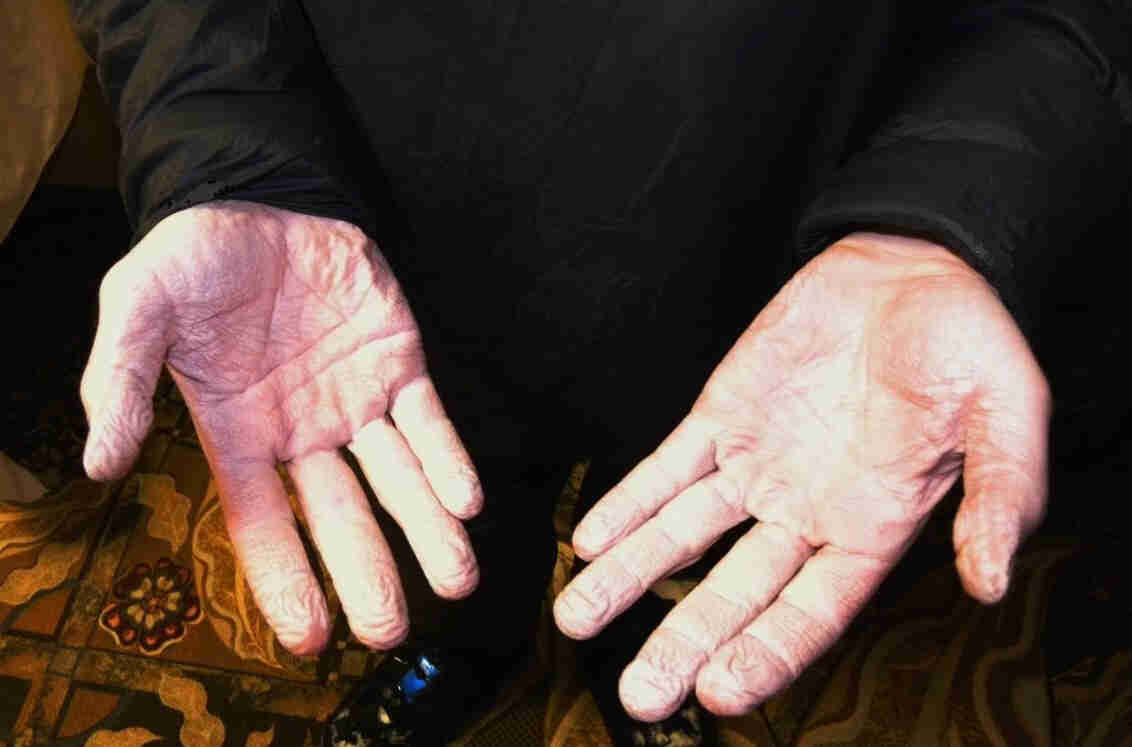
Fortunately, it doesn't take long for the soreness to subside. And the mind has an amazing way of hampering a good portion of the not-so-pleasant memories - the unavoidable periods of suffering - during the race. So when I got home, I did what I usually do: I made a list of all the things that worked well and all the things that didn't work well. I think there's a good chance that I'll be looking over that list, next year, as I plan for another snowy dash across the northern Minnesota wilderness. Sorry, Mom.

 Surly Bikes
Surly Bikes